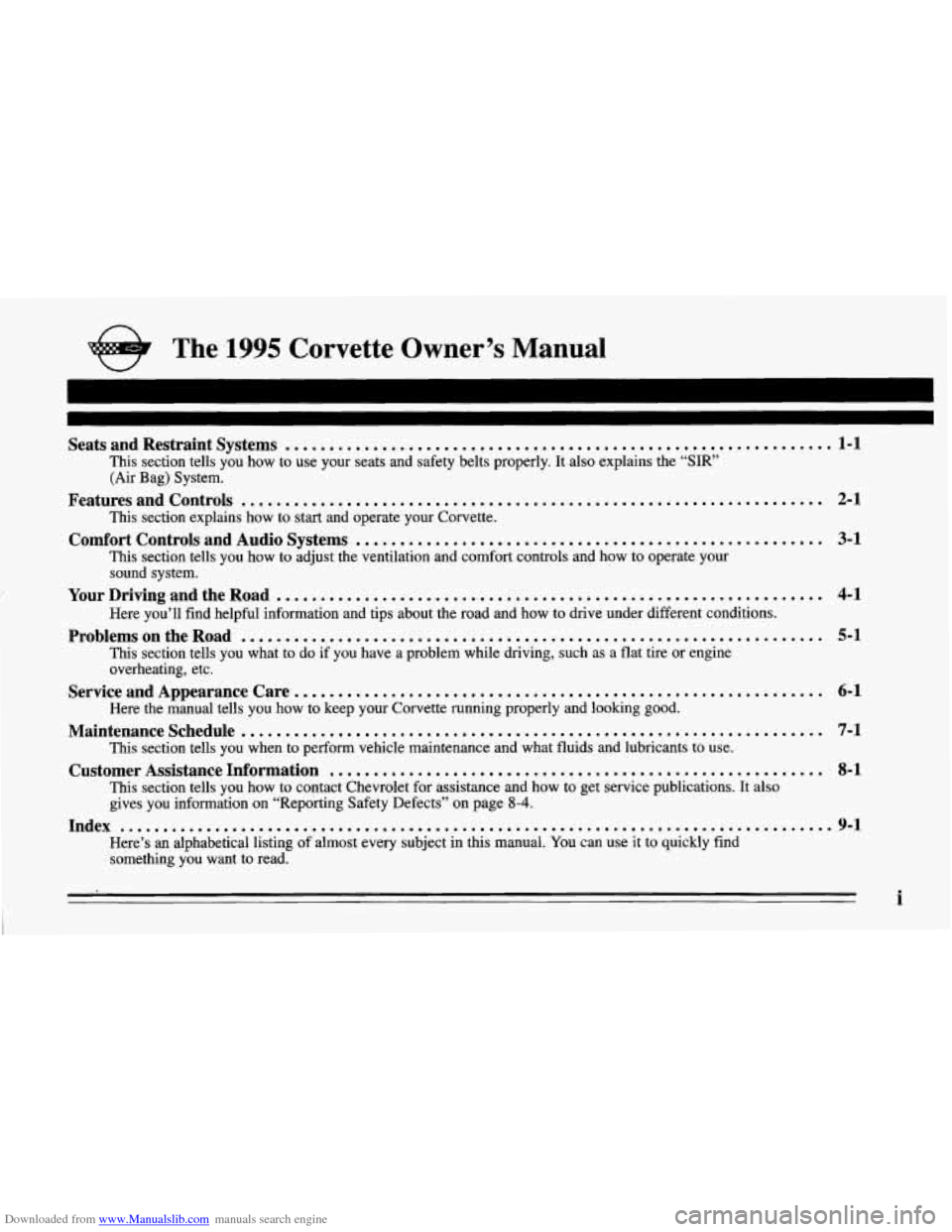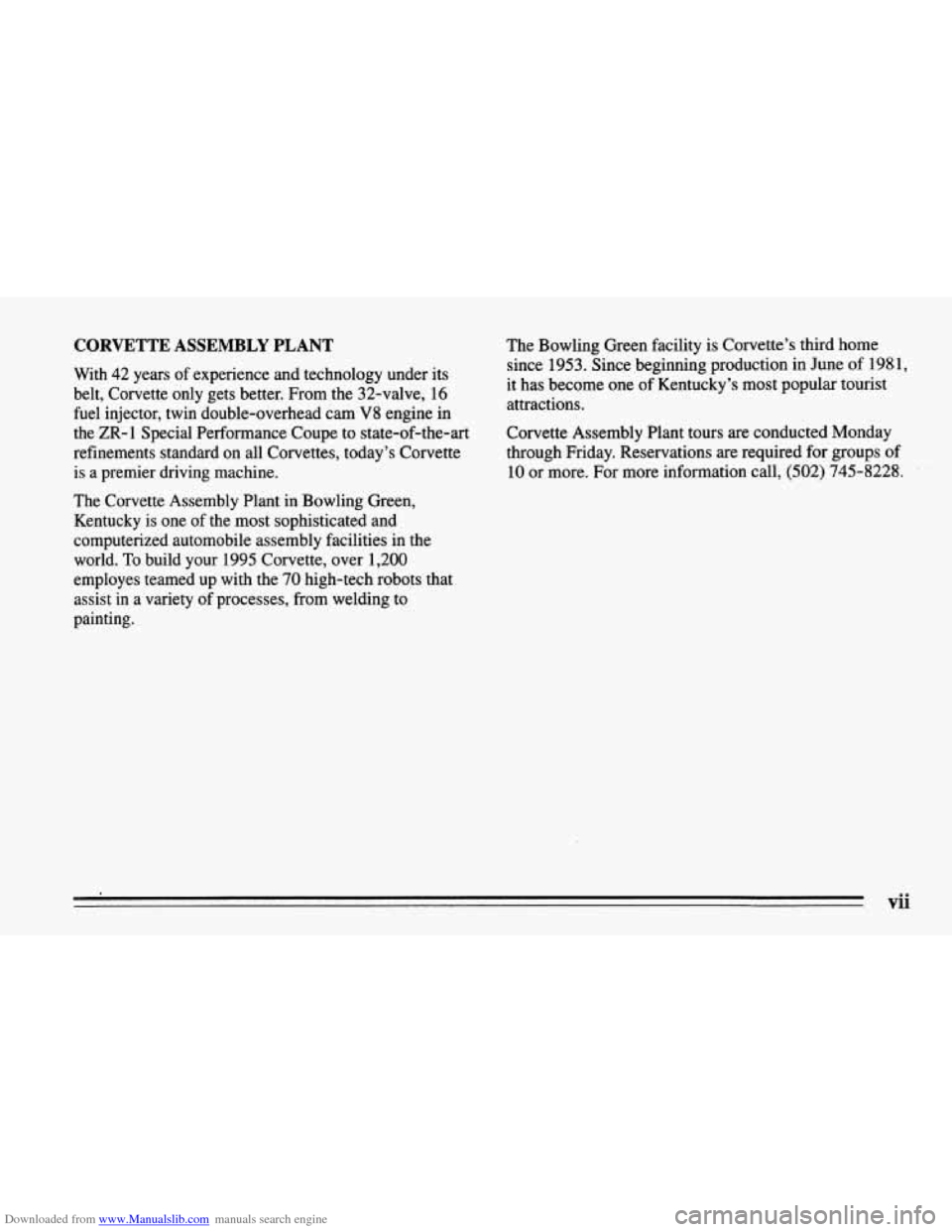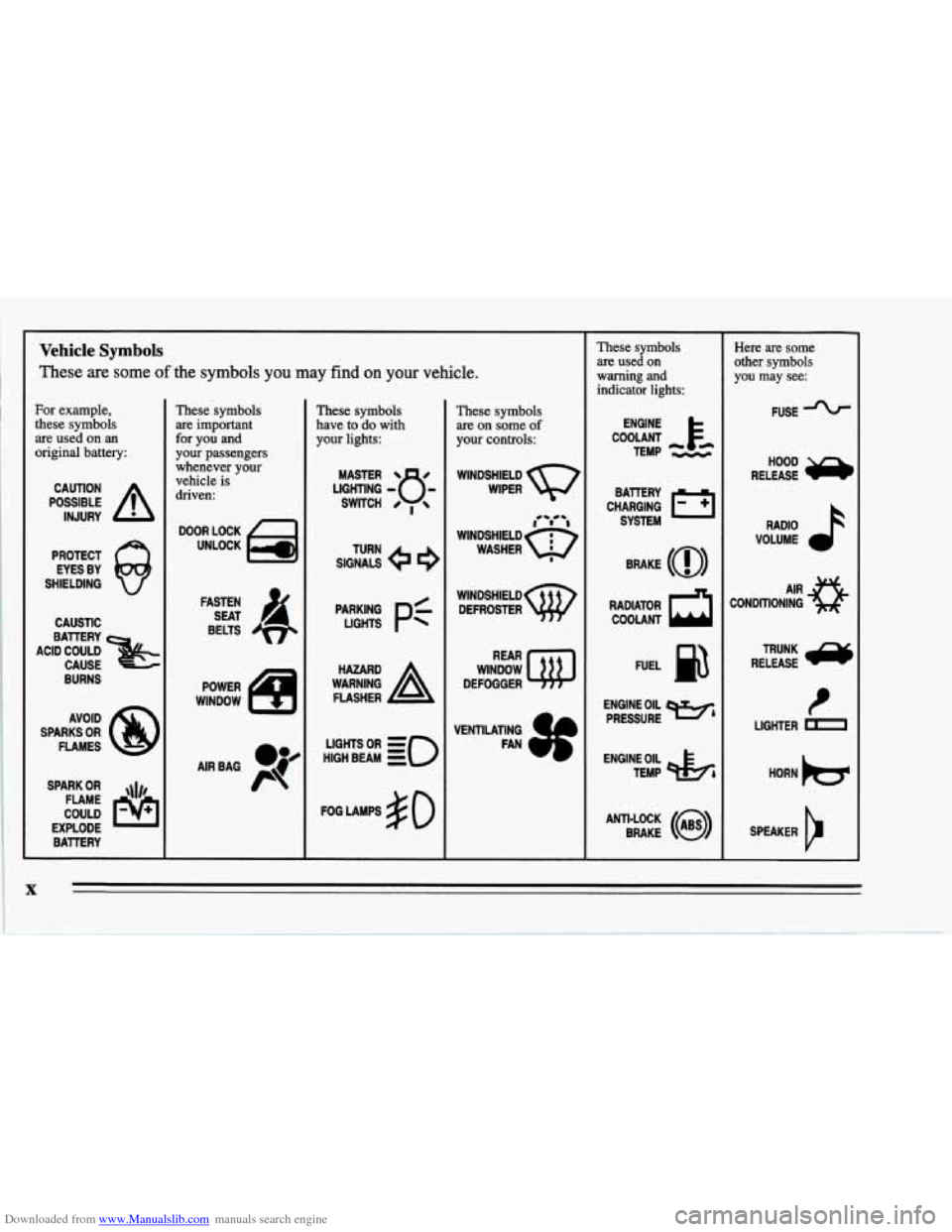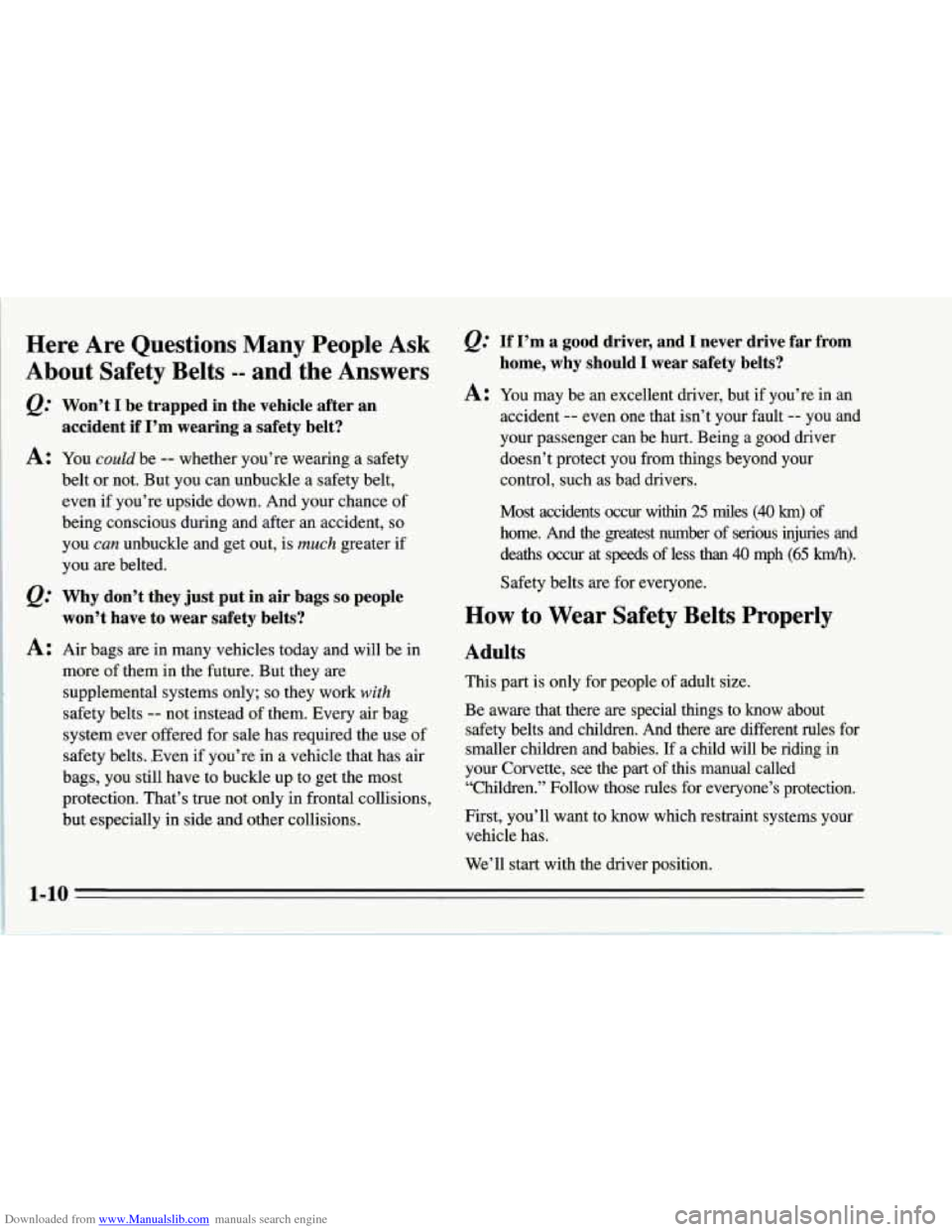Page 2 of 386

Downloaded from www.Manualslib.com manuals search engine n
The -1995 Corvette Owner’s Manual
Seats and Restraint Systems .............................................................. 1-1
This section tells you how to use your seats and safety belts properly. It also explains the “SIR’
(Air Bag) System.
This section explains how to start and operate your Corvette.
This section tells you how to adjust the ventilation and comfort controls and how
to operate your
sound system.
YourDrivingandtheRoad ..............................................................
Here you’ll find helpful information and tips about the road and how to drive under different conditions.
This section tells you what to do if
you have a problem while driving, such as a flat tire or engine
overheating, etc.
Here the manual tells
you how to keep your Corvette running properly and looking good.
Maintenanceschedule ..................................................................
This section tells you when to perform vehicle maintenance and what fluids and lubricants to use.
Customer Assistance Information ........................................................
This section tells you how to contact Chevrolet for assistance and how to get service publications. It also
gives you information on “Reporting Safety Defects” on page
8-4.
FeaturesandControls ..................................................................
Comfort Controls and Audio Systems .....................................................
ProblemsontheRoad ..................................................................
ServiceandAppearanceCare ............................................................
2-1
3-1
4-1
5-1
6- 1
7-1
8-1
Index ........................................................................\
......... 9-1
Here’s an alphabetical listing of almost every subject in this manual. You can use it to quickly find
something you want to read.
i
Page 8 of 386

Downloaded from www.Manualslib.com manuals search engine CORVETTE ASSEMBLY PLANT
With 42 years of experience and technology under its
belt, Corvette only gets better. From the 32-valve7 16
fuel injector, twin double-overhead cam
V8 engine in
the ZR-1 Special Performance Coupe to state-of-the-art
refinements standard on all Corvettes, today’s Corvette
is
a premier driving machine.
The Corvette Assembly Plant in Bowling Green,
Kentucky is one of the most sophisticated and
computerized automobile assembly facilities in the
world. To build your 1995 Corvette, over 1,200
employes teamed up with the
70 high-tech robots that
assist in a variety
of processes, from welding to
painting. The
Bowling Green facility is Corvette’s third home
since 1953. Since beginning production in June of 198
1,
it has become one of Kentucky’s most popular tourist
attractions.
Corvette Assembly Plant tours are conducted Monday
through Friday. Reservations are required for groups
of
10 or more. For more information call, (502) 745-8228.
vii
Page 11 of 386

Downloaded from www.Manualslib.com manuals search engine Vehicle Symbols
These are some of the symbols you may find on your vehicle.
For example,
these symbols
are used on an
original battery:
POSSIBLE A
CAUTION
INJURY
PROTECT EYES BY
SHIELDING
Q
CAUSTIC
ACID COULD
&
BATTERY CAUSE
AVOID
SPARKS
OR
FLAMES
SPARK
OR ,\I/,
COULD FLAME
EXPLODE BATTERY
These symbols
are important
for you and
your passengers whenever your
vehicle
is
driven:
DOOR LOCK
UNLOCK
FASTEN SEAT
4
BELTS
POWER
WINDOW
AIRBAG P
These symbols
have to do with
your lights:
SIGNALS e e
TURN
p:
HIGH BEAM OR = so
FOG LAMPS # 0
These symbols
are on some
of
your controls:
WINDSHIELD
WIPER
WINDSHIELD DEFROSTER
WINDOW
DEFOGGER
VENTILATING FAN
These symbols
are used
on
warning and
indicator lights:
ENGINE
TEMP
--
CHARGING I-1
BATTERY SYSTEM
RADIATOR
COOLANT a
FUEL
ENGINE OIL PRESSURE
Wb
TEMP OtL ctlb
ANTI-LOCK (@)
BRAKE
~~ ~~~ ~ ~~
Here are some
other symbols
you may see:
FUSE -%-
RELEASE
RADIO
VOLUME
CONDITIONING
AIR 43
t
LIGHTER D
HORN )cr
SPEAKER
b
X
Page 12 of 386
Downloaded from www.Manualslib.com manuals search engine n
e Section 1 Seats and Restraint Systems
Here you’ll find information about the seats in your
Corvette and how to use your safety belts properly.
You
can also learn about some things you should not do with
air bags and safety belts.
Seats and Seat Controls
This section tells you about the seats -- how to adjust
them, and also about reclining front seatbacks, seatback
latches and the folding rear seatback.
Manual Front Seat
Move the lever under the front of the seat to unlock it.
Slide the seat to where you want it. Then release the
lever and try
to move the seat with your body, to make
sure the seat is locked into place.
1-1
Page 16 of 386
Downloaded from www.Manualslib.com manuals search engine Safety Belts: They’re for Everyone
This part of the manual tells you how to use safety belts
properly.
It also tells you some things you should not do
with safety belts.
And it explains the Supplemental Inflatable Restraint,
or
“air bag” system.
Page 17 of 386
Downloaded from www.Manualslib.com manuals search engine Your vehicle has a light that comes on as a reminder to
buckle up. (See “Safety Belt Reminder Light” in the
Index.) A few crashes
are mild, and some crashes
can be so
serious that even buckled up a person wouldn’t survive.
But most crashes
are in between. In many of them,
people who buckle up can survive and sometimes walk
away. Without belts they could have been badly hurt or
killed.
After more than
25 years of safety belts in vehicles,
the facts
are clear. In most crashes buckling up does
matter
... a lot!
Why Safety Belts Work
When you ride in or on anything, you go as fast as it
goes.
In many states and Canadian provinces,
the law says to
wear safety belts. Here’s why: They work.
You never know if you’ll be in a crash. If you do have a
crash, you don’t know if it will be a bad one.
1-6
Page 20 of 386
Downloaded from www.Manualslib.com manuals search engine or the instrument panel . . . or the safety belts!
With safety belts, you slow down as the vehicle does.
You get more time to stop. You stop over more distance,
and
your strongest bones take the forces. That’s why
safety belts make such
good sense.
1-9
Page 21 of 386

Downloaded from www.Manualslib.com manuals search engine Here Are Questions Many People Ask
About Safety Belts
-- and the Answers
@ Won’t I be trapped in the vehicle after an
accident if I’m wearing
a safety belt?
A: You could be -- whether you’re wearing a safety
belt or not. But you can unbuckle a safety belt,
even if you’re upside down. And your chance of
being conscious during and after an accident,
so
you can unbuckle and get out, is much greater if
you are belted.
@ Why don’t they just put in air bags so people
A: Air bags are in many vehicles today and will be in
more of them in the future. But they are
supplemental systems only;
so they work with
safety belts -- not instead of them. Every air bag
system ever offered for sale has required the use of
safety belts. ,Even if you’re in a vehicle that has air
bags, you still have to buckle up to get the most
protection. That’s true not only in frontal collisions,
but especially in side and other collisions.
won’t have to wear safety belts?
QC If I’m a good driver, and I never drive far from
A: You may be an excellent driver, but if you’re in an
home, why should I wear safety belts?
accident -- even one that isn’t your fault -- you and
your passenger can be hurt. Being
a good driver
doesn’t protect you from things beyond your
control, such as bad drivers.
Most accidents occur within
25 miles (40 km) of
home. And the greatest number of serious injuries and deaths
OCCUT at speeds of less than 40 mph (65 km/h).
Safety belts are for everyone.
How to Wear Safety Belts Properly
Adults
This part is only for people of adult size.
Be aware that there are special things to know about
safety belts and children. And there are different rules for
smaller children and babies.
If a child will be riding in
your Corvette, see the part of this manual called
“Children.” Follow those rules for everyone’s protection.
First, you’ll want to know which restraint systems your
vehicle has.
We’ll start with the driver position.
1-10